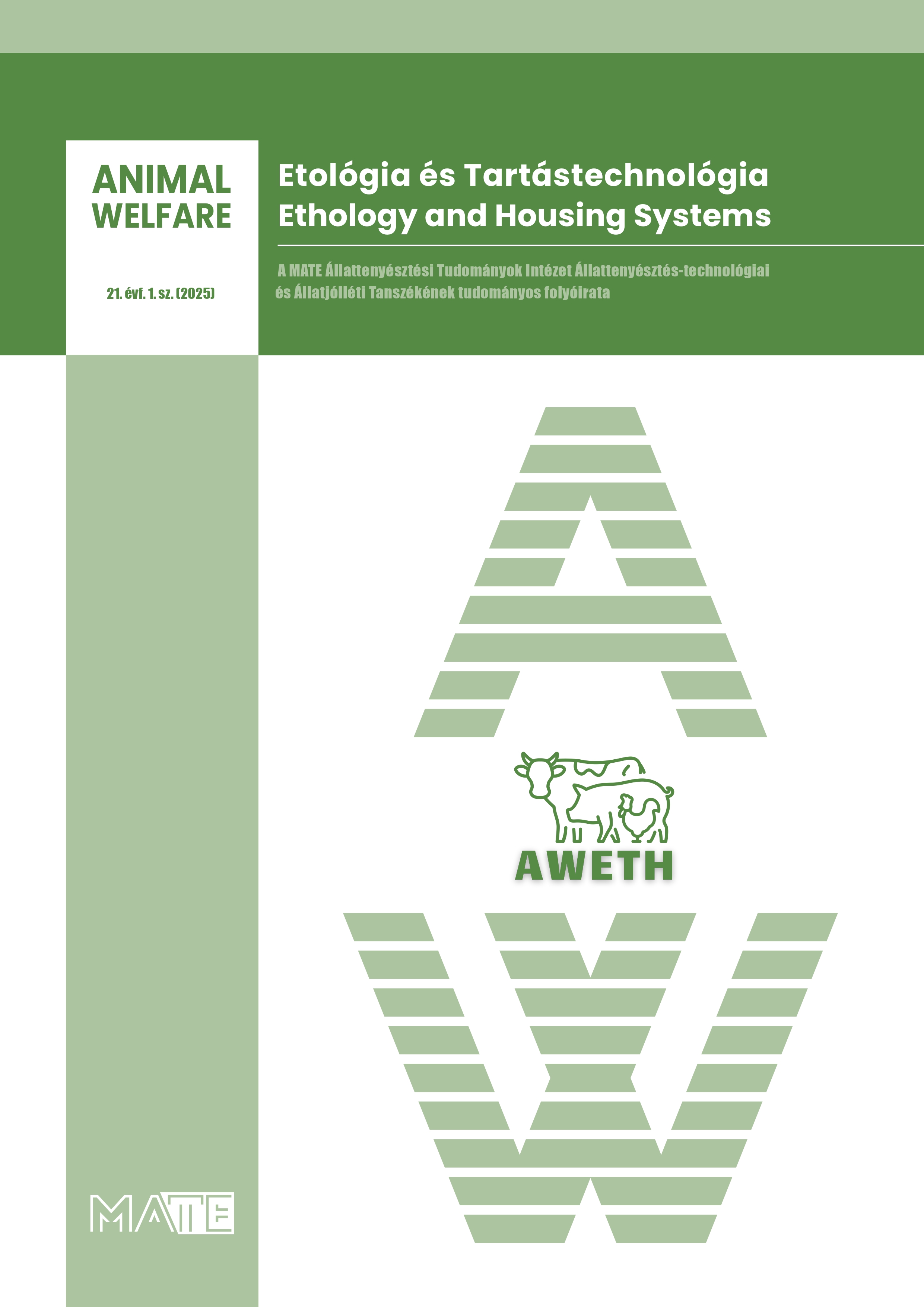Possibilities of disruptive selection in dachshunds, based on earthdog trial scores
DOI:
https://doi.org/10.17205/aweth.7056Kulcsszavak:
dachshund, hund work, family pet, selection gainAbsztrakt
Dachshunds are highly popular both historically and nowadays. They’re bred for hunting and their work is still necessary, mainly on blood tracks and in controlling red fox and badger populations. On other hand, the waste majority of these breeds are kept as family pets today, and in that role the same traits, what are essential for successful earthdog work are disadvantageous. We’ve obtained 156 earthdog trial results of 73 dogs, from eight events for modelling selection possibilities. As pedigree data of the dogs wasn’t suitable for determining it, we’ve used heritability values near h2 = 0,2 published for other populations, but to the same traits. The selection gain for hunting eagerness to the next generation would be between 4.23–4.65 scores (max. 100) with different selections pressures, while – 9.19 scores for pet purposes. In case of barking endurance future earthdogs could improve with 6,4 seconds, while dachshunds kept as companion animals could bark 8.89 s less when once started, if the population participated on trials had been a breeding stock.
Hivatkozások
Baranyiova, E., Holub, A., Tyrlik, M. (2007): Behavioural Traits of Four Dog Breeds in Czech Households. Acta Veterinaria Brno, 76, 627–634. https://doi.org/10.2754/avb200776040627
Bednarek, E., Slawinska, A. (2021): Hunt trials as a measure to access level of training in boarhounds. Animals, 11, 1661. https://doi.org/10.3390/ani11061661
Brenoe, U. T, Larsgard, A. G., Johannessen, K-R., Uldal, S. H. (2002): Estimates of genetic parameters for hunting performance traits in three breeds of gun hunting dogs in Norway. Applied Animal Behaviour Science, 77, 209–215. https://doi.org/10.1016/S0168-1591(02)00050-3
Diezel E., Mika K. (1910): Vadászebek. Szukits Könyvkiadó, Szeged,146 p.
Gonzalez Martinez, A., Santamaria Pernas, G. Castalta, J. D. Suarez Rey, M. L., De la Cruz Palomino, L. F. (2011): Risk factors associated with behavioral problems in dogs. Journal of Veterinary Behavior, 6, 225–231. https://doi.org/10.1016/j.jveb.2011.01.006
Hart, B. L., Miller, M. F. (1985): Behavior profiles of dog breeds. Journal of the American Veterinary Medical Association, 186, 1175–1180. https://doi.org/10.2460/javma.1985.186.11.1175
Kasarda, R., Chudejová, I., Chudej, P., Kadlečík, O. (2007): Heritability of hunting performance traits of dachshound in Slovakia. Folia Veterinaria 51. 26–29.
King, T., Marston L. C., Bennett P. C. (2009): Describing the ideal Australian companion dog. Applied Animal Behaviour Science, 120(1), 84–93. https://doi.org/10.1016/j.applanim.2009.04.011
Lindberg, S, Strandberg, E., Swenson, L. (2004): Genetic analysis of hunting behaviour in Swedish flatcoated retrievers. Applied Animal Behaviour Science, 88(3–4), 289–298. https://doi.org/10.1016/j.applanim.2004.03.007
Nappe, S (2013): A tacskó. Cser Kiadó, Budapest, 91 p.
Serpell, J. A., Duffy, L. D. (2014): Dog breeds and their behavior. In: A. Horowitz (ed.), Domestic Dog Cognition and Behavior, Springer-Verlag Berlin Heidelberg. https://doi.org/10.1007/978-3-642-53994-7_2
Serpell, J. A., Hsu, Y. (2005): Effects of breed, sex, and neuter status on trainability in dogs. Anthrozoös, 18(3), 196–207. https://doi.org/10.2752/089279305785594135
Stephens-Lewis, D. Schenke, K. C. (2023): 'Obedient, but cheeky': Human expectations of canine behaviour and companionship. PsyArXiv. January 25. PsyArXiv. 2023. January 25. https://doi.org/10.31234/osf.io/t4bvd
Svartberg, K. (2005): Breed-typical behaviour in dogs - Historical remnants or recent constructs? Applied Animal Behaviour Science, 96(3–4), 293–313. https://doi.org/10.1016/j.applanim.2005.06.014
Tabel, C. Tabel, U. (2018): A fiatal vadászkutya. Fehér Mihály – Kertész Sándor – Nimród Vadászújság, Budapest, 138 p.
Yamada, R., Kuze-Arata, S., Kiyokawa, Y., Takeuchi, Y. (2019): Prevalence of 25 canine behavioral problems and relevant factors of each behavior in Japan. The Journal of Veterinary Medical Science, 81(8), 1090–1096. https://doi.org/10.1292/jvms.18-0705
Wilson, B., Serpell, J., Herzog, H., McGreevy, P. (2018): Prevailing clusters of canine behavioural traits in historical US demand for dog breeds (1926–2005). Animals 8, 197. https://doi.org/10.3390/ani8110197
Letöltések
Megjelent
Folyóirat szám
Rovat
License
Copyright (c) 2025 Tamás Mészöly, Natasa Fazekas

This work is licensed under a Creative Commons Attribution-NonCommercial-NoDerivatives 4.0 International License.
A folyóirat a nyílt hozzáférés elvei szerint működik, cikkeire ugyanakkor a Creative Commons 4.0 standard licenc alábbi típusa vonatkozik: CC-BY-NC-ND-4.0. Ennek értelmében a mű szabadon másolható, terjeszthető, bemutatható és előadható, azonban nem használható fel kereskedelmi célokra (NC), továbbá nem módosítható és nem készíthető belőle átdolgozás, származékos mű (ND). A licenc alapján a szerző vagy a jogosult által meghatározott módon fel kell tüntetni a szerző nevét és a szerzői mű címét (BY).














